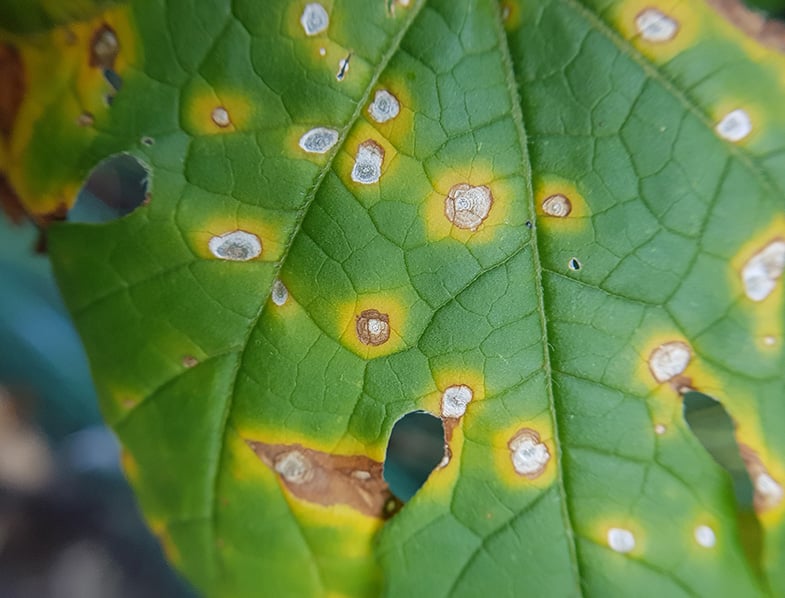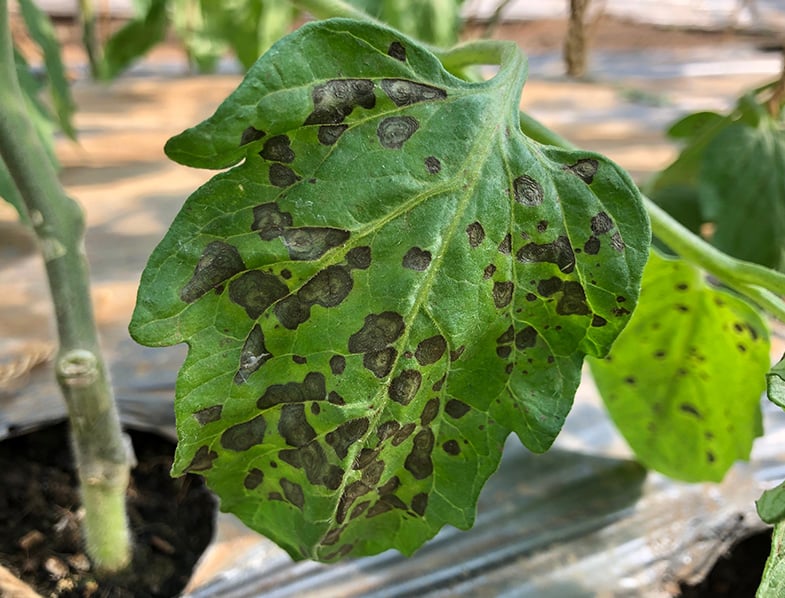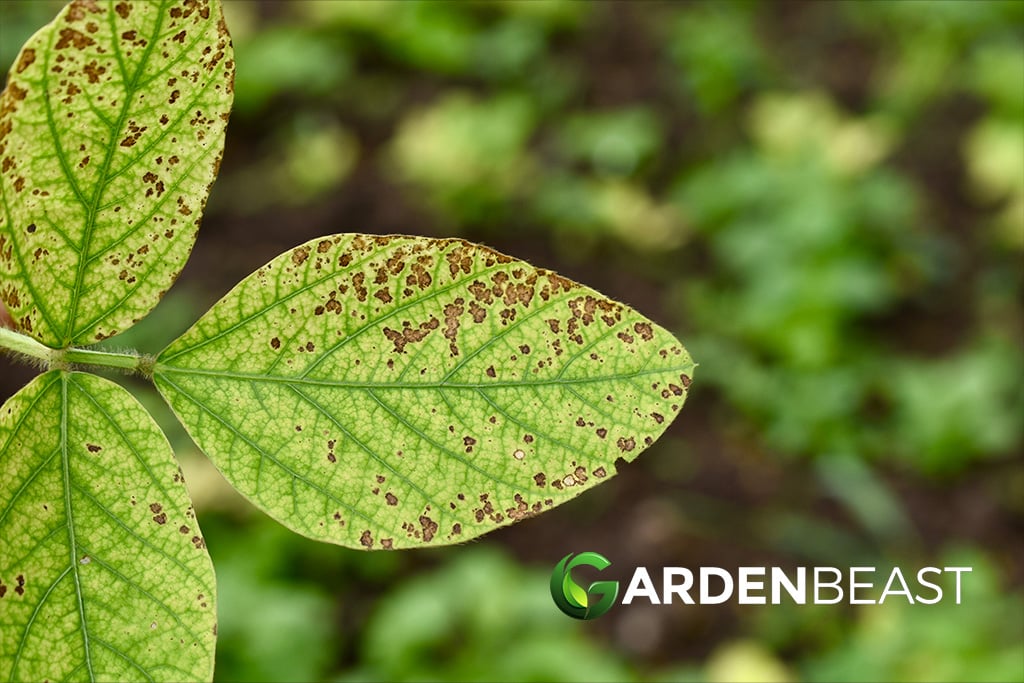The following article discusses leaf spot infestation and how to manage it. Keep reading to learn more about this and how to get rid of leaf spots in an eco-friendly way.
The passion for having and tending for plants can be incredibly fulfilling and rewarding, no matter how experienced you are as a gardener. Creating your own indoor garden of tropical houseplants or developing a wonderful backyard garden has many advantages. Besides enhancing the aesthetic of your apartment or house, growing a garden can also have health benefits. First of all, the presence of plants can freshen up the air we breathe by removing toxins from it. Secondly, whether you start building your houseplant collection indoors or you have a large garden in your backyard, there is no denying that having such a recreational space will boost your energy levels and improve your overall well-being.
This being said, it is crucial to acknowledge that there are some risks involved when taking care of a garden, regardless of its size or number of plants. As well as you tend to your plants, they can still develop diseases or get infested with various pests. However, don’t worry. This doesn’t mean all is lost. More often than not, there is a solution and treatment you can apply to save your plant, depending on the type of disease and how fast you managed to catch it. Understandably, if you are a novice gardener, seeing your plants getting sick can be scary. Thankfully, you have come to the right place.
One of the most frequently occurring diseases plants become infested with is leaf spotting, either caused by bacteria or fungus. Next, we will discuss this disease in more detail, we’ll make a list of the type of plants that are usually affected by leaf spots, and how to manage or prevent this disease.
What Is Leaf Spot?
As the name clearly implies, this disease manifests as the appearance of unusual, discoloured, and ill-looking spots on various plants and trees’ foliage. Because the foliage is immediately and clearly affected by this disease, leaf spots are not challenging to observe and diagnose. It may not seem like it, but this is good news. As a gardener, especially a beginner one, being able to observe a disease almost as soon as it happens is the best-case scenario. This way, you can start tackling the issue right away.
The leading cause of leaf spots is fungi, but a large number of leaf spots are also caused by bacteria. In either case, the appearance of the damaged leaf is similar, and so is the effect of this disease on the plant. Therefore, the practices do not differ when it comes to preventive measures and courses of treatment. Whether your plant is suffering from leaf spots caused by fungus or bacteria, what you need to do to treat your plant is similar in both cases. This makes your job easier, as you can simply start applying infestation management strategies.
So, let’s see what this infestation looks like and what types of plants are usually affected. Plus, you will surely want to know how to prevent your healthy plants from developing leaf spots as well as how to treat them in case these frustrating leaf spots have already started forming on the foliage.

Types Of Plants Affected by Leaf Spot
Because leaf spot is a widely common infestation, it can affect various plants of different types and varieties, from vegetables to ornamental plants. Even though leaf spot is such a common infestation and there are very few plants that are out of danger, the positive aspect of this is the fact that it is not a lethal disease, plants being able to survive leaf spot fungus. What’s more, there are some trees that can tolerate it, without being too damaged. However, you can do things to prevent them from getting the disease in the future, like removing infected foliage or using any fungicides, if truly necessary.
So, some of the plants that can be affected by this unthreatening yet damaging disease include the flowering plant used as a herbal remedy, Echinacea, or the wonderful Chrysanthemum or Hypericum. The list can go on and on, with other excellent plants that are extremely popular in gardens worldwide, such as Delphiniums or Astilbes. It is important to remember that the great majority of flowering plants in your garden can get infested with leaf spots, given that the bacteria can easily and rapidly spread from one plant to another by rain or overhead heavy irrigation.
Apart from ornamental plants, leaf spot is a disease that can also affect vegetables and fruits. Whether it is caused by fungal or bacterial pathogens, this disease is represented by these necrotic spots on foliage, and they can quickly appear on any type of plant. For instance, there is Septoria leaf spot, a disease common to fruits and vegetables, like tomatoes, celery, lettuce, passionfruit, and citrus fruits. As a general rule, the first, most common, and similar symptom is the emergence of these small typical “dead” spots on the leaves that grow and spread over time.
A noteworthy mention would be to be mindful of the fact that leaf spots can be host-specific, meaning that each plant can be affected by a different type of Septoria leaf spot. For instance, tomatoes can get ill with Septoria lycopersici. In this case, only the leaves are affected, but not the fruit, unlike Septoria passiflorae, the leaf spots of passionfruit.
Therefore, while the majority of plants are affected by this leaf spot disease, it is vital to conduct a bit of thorough research if your garden collection features many types of plants or if you grow your own vegetables and fruits. So, if you are unsure of how leaf spots can affect your plants, it is better to be safe than sorry and make sure there are no plants with the ability to develop host-specific leaf spots.
How To Better Manage and Get Rid of Leaf Spots
Even though this disease is not one to be feared, given that it is not lethal and it will not seriously harm your plants with no way of saving them, it is still necessary to learn how to manage leaf spots better when they do appear on your plants. With effective leaf spot diseases management, you may be able to get rid of them altogether. Alternatively, what you will manage to do with this is to significantly decrease the chances of your plants and trees getting this disease in the following years.
One easy way of better managing leaf spots is to remove all the infected leaves and any dead twigs that may also be affected. This way, you may be able to control de infestation, given that you are removing all the spores, which can easily affect the remaining unaffected foliage. While this is not a cure, it is an effective infestation management strategy, as is keeping the leaves dry.
Not watering the foliage doesn’t mean not watering the plant. What you should always do is to water your plants at the base and avoid overhead watering at all times, as this is how leaf spots can quickly spread, infecting other plants immediately. For the same reason, you should never have overcrowded plants. The best spacing guide when it comes to planting is to take a plant’s maturity size into consideration, which will allow all your plants to grow beautifully and at a safe distance from one another.
While most plants and trees can tolerate living with leaf spots on their foliage without being too damaged, apart from the prominent spots on leaves, this is not always the case. When a tree or plant re-leaves, chances are the new foliage won’t be affected. However, some gardeners prefer getting rid of leaf spots by replacing the plant altogether, especially if it keeps getting affected by this disease. Usually, the replacement is a plant more resistant, although one cannot know for sure.
Another method of diminishing the severity of the leaf spot infestation is using fungicides. Such sprays do not act as a cure, as, unfortunately, there are few possibilities of treating a plant entirely. But applying fungicides while buds break in the spring could help reduce the risk of developing leaf spots when the plant reaches maturity.
Last but not least, if any of your plants start developing leaf spots, you don’t have to worry about a severe infestation right away. If you keep them healthy and you tend to them correctly, even if they develop leaf spots, chances are they will be able to rebound quite fast. This is an incredible trait characteristic of plants, especially since the majority of them can survive just well when defoliated.

3 Eco-Friendly Organic Preventive Measures to Avoid Leaf Spot Infestation
Because, as mentioned above, there is no cure for plants that are infected with bacterial leaf spots, and treating this disease doesn’t involve one specific method, it is of the utmost importance to learn how to prevent this from happening. As a gardener, it will be helpful to know the following three eco-friendly and organic preventive measures even if none of your plants are suffering from leaf spot infestation.
1. Watering From Overhead
As mentioned above, rain and overhead watering encourage the spread of leaf spots. Fortunately, you can control the latter. Therefore, if you have a large backyard garden, you should not water your plants from above, as this can also damage the foliage and flowers, apart from spreading diseases. Instead, always water them at the base.
2. Baking Soda Solution
One of the best organic preventive measures entails creating a homemade solution, so it is definitely eco-friendly. All you need for this is a tablespoon of baking soda, two and a half tablespoons of vegetable oil, a teaspoon of liquid soap (but not detergent, so be careful not to mistake the two) mixed into a gallon of water. This is an effective preventive measure to keep plantt diseases away. However, start spraying only a few leaves to make sure that no adverse reactions happen. If all is safe, you can use this solution every two weeks. Another measure you could apply instead of baking soda solution is neem oil.
3. Use Organic Fungicides
When you first hear of fungicides, especially as a novice gardener, you may think they are among those pesticides that contain highly toxic chemicals which are damaging to the environment. However, this is not always the case. Luckily, there are some organic fungicides, such as sulfur sprays or copper-based fungicides, that can be safely used for plants that start showing signs of disease.
So, if you notice leaf spots on any type of plant, you can immediately start applying these organic fungicides mentioned above. The application should be done weekly from the moment when you first see the leaf spot infestation in order to prevent or diminish its spread. Unfortunately, these organic fungicides aren’t able to cure the leaf spot entirely. Their efficient role is to prevent the spores from germinating. But the good news is that organic fungicides are among the most recommended preventive measures.

Dr. Earth 8007 Ready to Use Disease Control Fungicide
In Conclusion
Identifying leaf spots is not difficult. As a gardener, regardless of the level of experience, quickly spotting a disease is always the preferred alternative. This way, you can apply any courses of treatment or learn necessary preventive measures right away so that you know what needs to be done if or when this happens again. In the case of leaf spots, you should check the lower and inner branches of a plant first. This is where they usually start appearing, given that in that area, humidity levels are higher.
The discoloration of leaf spots can also be easily identified, as the yellow and brown or black “dead” spots cannot be missed. Although there are no cures for leaf spot disease, the good news is that leaf spots do not severely damage the plants, and it is not a lethal disease. This also means that some plants and trees can live with leaf spots for a long time. In addition, when it is time to re-leaf, trees may not even have this disease. But if you notice your plants suffering from leaf spots, there are preventive measures you can apply or ways of controlling this disease, reducing its spread, like removing affected plants.
Have your plants been affected by leaf spot disease? Let us know in the comment section!
